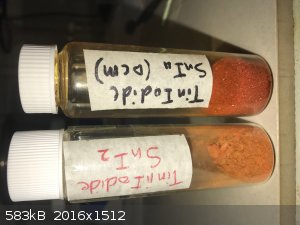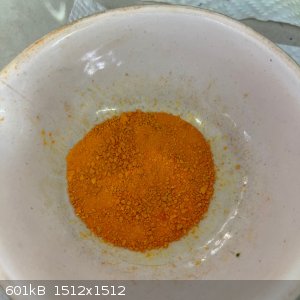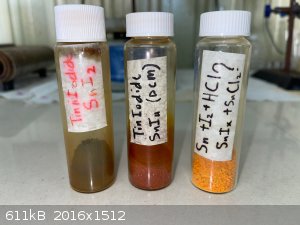Lion850
National Hazard
   
Posts: 514
Registered: 7-10-2019
Location: Australia
Member Is Offline
Mood: Great
|
|
Tin orange iodine / chlorine compound with stable color
In this post I reported how I got an orange compound after dissolving tin granules in a solution of iodine in concentrated hydrochloric acid:
http://www.sciencemadness.org/talk/viewthread.php?tid=156987...
I assumed the product was SnI4, which I made a few times by reacting tin with iodine in DCM. But this product that I got from doing the reaction in
HCl behaves differently on the shelf.
I store my salts in clear glass vials because I want to see the colors. This means that over time many of my metal iodides darken, some more and some
less. Each time I made SnI4 and SnI2 they darkened over time. But the orange salt made from the tin - iodine - HCl reaction is keeping its color.
SnI2 and SnI4 made 8 months ago:

The salt made by reacting tin and iodine in HCl some 4 months ago:

The 3 salts as they look now:

This leads me to wonder why the 'acid salt' apparently do not loose iodine. Is it maybe indeed not SnI4 but a tin-iodine-chlorine complex?
|
|
|
garphield
Hazard to Self
 
Posts: 58
Registered: 9-12-2019
Member Is Offline
|
|
Was this an aqueous solution of HCl or was it dissolved in something else? If it was the former, this is probably some kind of oxychloride(+iodide)
which would explain why it's more air-stable.
|
|
|
Lion850
National Hazard
   
Posts: 514
Registered: 7-10-2019
Location: Australia
Member Is Offline
Mood: Great
|
|
Hi Garphield yes it was 'swimming pool' hydrochloric acid which is around 32% (it fumes in air).
|
|
|
Amos
International Hazard
    
Posts: 1406
Registered: 25-3-2014
Location: Yes
Member Is Offline
Mood: No
|
|
I have made tin iodide before that forms large, shiny, dichromate-colored crystals, much more intense in color than your solid. If you want to follow
my method, I simply left tin metal and iodine dissolved in benzene together in a closed and sealed vial, and used a hot water bath to speed up the
reaction sometimes, but not consistently. After several days the benzene was deep orange in color, and upon leaving the vial open outdoor it
evaporated to yield beautiful crystals. Keep it out of sunlight! I hope you'll give it a shot. Toluene might work too but I believe iodine is more
soluble in benzene.
|
|
|
Lion850
National Hazard
   
Posts: 514
Registered: 7-10-2019
Location: Australia
Member Is Offline
Mood: Great
|
|
Hi Amos sorry for much delayed reply but I do not have benzene so never tried.
What still intrigues me is that now, 8 months later, the above mentioned "Sn + I2 + HCl" is still exactly the same orange color, while the SnI2 and
SnI4 are by now both very dark (they are exposed to indirect sunlight).
Online is mentioned a compound Tin (iv) chloride iodide Cl2I2Sn, but unfortunately none of the suppliers I could find mentions the color and I also
could not find a photo. In the next days I will repeat the experiment and follow the stoichiometry this equation:
Sn + I2 + 2HCl = SnCl2I2 + H2
and I will use reasonable amounts (few grams) so that the final product weight will hopefully give an indication of what could have formed, what
apparently is so much more stable than the other 2.
|
|
|
MidLifeChemist
Hazard to Others
  
Posts: 192
Registered: 4-7-2019
Location: West Coast USA
Member Is Offline
Mood: precipitatory
|
|
Perhaps you can test this compound and see if you can release elemental iodine or chlorine from it. That may shed some light on its composition, or at
least run in/out SnCl2I2
|
|
|
Lion850
National Hazard
   
Posts: 514
Registered: 7-10-2019
Location: Australia
Member Is Offline
Mood: Great
|
|
I stumbled across the Wikipedia page for SnI2
https://en.wikipedia.org/wiki/Tin(II)_iodide
which mentions reacting tin and iodine in hydrochloric acid to make SnI2. So I think that is what I got. And now, 2 years after making it with the
vial standing unshielded on the shelf, the orange color is still exactly the same. Seems to be a very stable iodine salt.
|
|
|